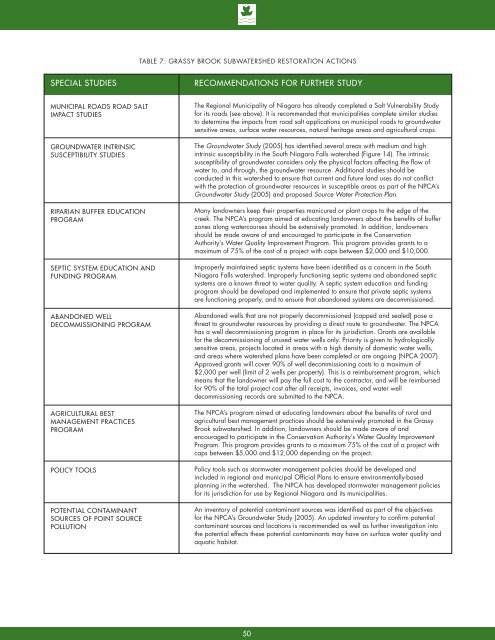8132 - NPCA SNF Watershed Report.indd - Niagara Peninsula ...
8132 - NPCA SNF Watershed Report.indd - Niagara Peninsula ...
8132 - NPCA SNF Watershed Report.indd - Niagara Peninsula ...
You also want an ePaper? Increase the reach of your titles
YUMPU automatically turns print PDFs into web optimized ePapers that Google loves.
table 7: Grassy brook subwatershed restoration actionsSPECIAL STUDIESRECOMMENDATIONS FOR FURTHER STUDYMUNICIPAL ROADS ROAD SALTIMPACT STUDIESGROUNDWATER INTRINSICSUSCEPTIBILITY STUDIESRIPARIAN BUFFER EDUCATIONPROGRAMSEPTIC SYSTEM EDUCATION ANDFUNDING PROGRAMABANDONED WELLDECOMMISSIONING PROGRAMAGRICULTURAL BESTMANAGEMENT PRACTICESPROGRAMPOLICY TOOLSPOTENTIAL CONTAMINANTSOURCES OF POINT SOURCEPOLLUTIONThe Regional Municipality of <strong>Niagara</strong> has already completed a Salt Vulnerability Studyfor its roads (see above). It is recommended that municipalities complete similar studiesto determine the impacts from road salt applications on municipal roads to groundwatersensitive areas, surface water resources, natural heritage areas and agricultural crops.The Groundwater Study (2005) has identified several areas with medium and highintrinsic susceptibility in the South <strong>Niagara</strong> Falls watershed (Figure 14). The intrinsicsusceptibility of groundwater considers only the physical factors affecting the flow ofwater to, and through, the groundwater resource. Additional studies should beconducted in this watershed to ensure that current and future land uses do not conflictwith the protection of groundwater resources in susceptible areas as part of the <strong>NPCA</strong>’sGroundwater Study (2005) and proposed Source Water Protection Plan.Many landowners keep their properties manicured or plant crops to the edge of thecreek. The <strong>NPCA</strong>’s program aimed at educating landowners about the benefits of bufferzones along watercourses should be extensively promoted. In addition, landownersshould be made aware of and encouraged to participate in the ConservationAuthority’s Water Quality Improvement Program. This program provides grants to amaximum of 75% of the cost of a project with caps between $2,000 and $10,000.Improperly maintained septic systems have been identified as a concern in the South<strong>Niagara</strong> Falls watershed. Improperly functioning septic systems and abandoned septicsystems are a known threat to water quality. A septic system education and fundingprogram should be developed and implemented to ensure that private septic systemsare functioning properly, and to ensure that abandoned systems are decommissioned.Abandoned wells that are not properly decommissioned (capped and sealed) pose athreat to groundwater resources by providing a direct route to groundwater. The <strong>NPCA</strong>has a well decommissioning program in place for its jurisdiction. Grants are availablefor the decommissioning of unused water wells only. Priority is given to hydrologicallysensitive areas, projects located in areas with a high density of domestic water wells,and areas where watershed plans have been completed or are ongoing (<strong>NPCA</strong> 2007).Approved grants will cover 90% of well decommissioning costs to a maximum of$2,000 per well (limit of 2 wells per property). This is a reimbursement program, whichmeans that the landowner will pay the full cost to the contractor, and will be reimbursedfor 90% of the total project cost after all receipts, invoices, and water welldecommissioning records are submitted to the <strong>NPCA</strong>.The <strong>NPCA</strong>’s program aimed at educating landowners about the benefits of rural andagricultural best management practices should be extensively promoted in the GrassyBrook subwatershed. In addition, landowners should be made aware of andencouraged to participate in the Conservation Authority’s Water Quality ImprovementProgram. This program provides grants to a maximum 75% of the cost of a project withcaps between $5,000 and $12,000 depending on the project.Policy tools such as stormwater management policies should be developed andincluded in regional and municipal Official Plans to ensure environmentally-basedplanning in the watershed. The <strong>NPCA</strong> has developed stormwater management policiesfor its jurisdiction for use by Regional <strong>Niagara</strong> and its municipalities.An inventory of potential contaminant sources was identified as part of the objectivesfor the <strong>NPCA</strong>’s Groundwater Study (2005). An updated inventory to confirm potentialcontaminant sources and locations is recommended as well as further investigation intothe potential effects these potential contaminants may have on surface water quality andaquatic habitat.50
















